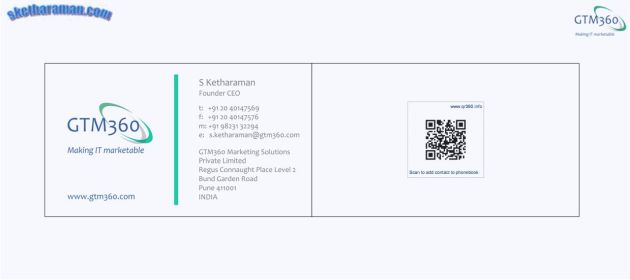After seeing the QR code on the back of my business card, a customer recently congratulated me for the nice hack which let him add my contact to his mobile phone in a single tap.
But before I could bask in the praise, he rained on my parade by asking, “Are business cards relevant in this digital age?”
Although the question punctured my “collar-up” moment, it was valid. I won’t be surprised if some of you have the same question in your mind as you’re reading this now.
My answer, in a word, is YES.
The good old printed business card is not only still relevant but, in certain contexts like enterprise sales, it’s indispensable.
It’s well known that purchase decisions in large corporations are made by committees. For big ticket B2B technology purchases, the committee comprises 6-8 members. In addition, there are 2-3 others outside the committee who play a role in selecting the vendor.
To succeed in enterprise sales, you need to engage with most, if not all, of these people.
At the start of the sales cycle, you know one or two committee members at the most. They’re the “primary contacts” who have reached out to you (or the ones your SDRs connected with while prospecting).
You begin by establishing contact with these primary contacts. But, as any successful enterprise salesperson knows, it’s necessary to go further and “case the joint” aka map the other committee members and non-members (collectively called “other decision makers”).
In theory, everybody is nice and is working in the best interest of their company, so your primary contacts will voluntarily introduce you to the other decision makers. But, in actual practice, office politics and dozen other things come in the way. In many companies, primary contacts will rarely connect you to the other decision makers. In some of them, they will give you broad hints not to go beyond them. In extreme cases, they may even tell you explicitly not to contact the other decision makers.
Regardless of what they say, you can’t give up. To win, you must case the joint. At the same time, you need to to do this without antagonizing your primary contacts. Here are a few ways to do that.
Case The Joint – Primer
- Ask security guards, front office staff and others you come across about who handles what in their company. When you do that, some of them might be wondering who the heck you are. You can establish your credentials quickly by handing out your business card. You’ll find tongues loosening immediately after that.
- “Bump into” the other decision makers – or their secretaries – informally at the cafeteria, water cooler, parking lot. Mutter a quick hello and offer your business card. If you give someone your business card, it’s human nature for that someone to give you their business card in return.
- Take along your colleagues from other functions (e.g. presales, business analysts, implementation) for customer meetings. Because it’s in human nature to seek a balance in numbers, you can be sure that your primary contacts will bring at least one or two of their coworkers for the meeting. Hand out business cards of everyone in your team liberally. You can be sure to receive many business cards in return.
“Case the Joint” mission accomplished!
As you can see, the business card establishes authenticity and unmasks identities, apart from just sharing contact info.
I’m all for using digital tools like LinkedIn profiles and email signatures for sharing contact info but, as you can see, they won’t help a sales rep to establish the first contact.
In short, to case the joint, there’s no substitute for the good old business card.
A recent Times of India article entitled Are business cards still relevant? echoes my above thoughts and provides a few more reasons for continuing the good old practice of using business cards.
- Sales people tell you that the only thing that people remember is the business card
- It’s the first point of contact with the client or anyone new
- 10 billion cards are printed annually in the USA. 8 billion of these are tossed within a week. But a company’s sales increase 2.5% for every 2,000 business cards handed out.
Don’t overthink a business card’s utility. Treat it like any other marketing collateral.
The cost of a business card – like a brochure or white paper – is insignificant in the larger scheme of things in enterprise deals. It’s okay even if it’s chucked. Effectiveness is more important than efficiency.
In B2B, never hesitate to invest in marketing. You can recover the cost of printing a new brochure even if it helps you bag just one new deal. IOW, Return on Marketing Investment is extremely high in B2B – as high as 565 sometimes. https://t.co/LM0v2os3ad . #ROMI
— Ketharaman Swaminathan (@s_ketharaman) July 11, 2019
If you’re now convinced that business cards still matter and would like to add a QR code with your contact info to your business card, you may find some useful information in my post entitled Which Is Best For Business Card QR Codes – MeCard Or VCF?.
Who knows, when your prospects and customers see the QR code, they might congratulate you for the hack, like mine did. But, unlike mine, your moment of glory need not be brief: If any of them asks you if business cards are relevant in this day and age, you can answer them immediately by directing them to this blog post!

